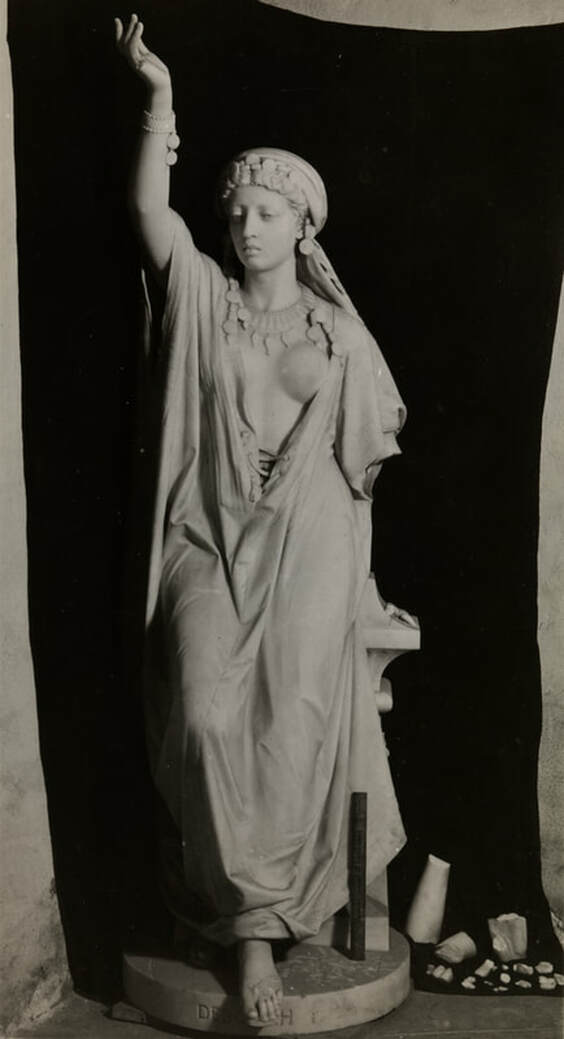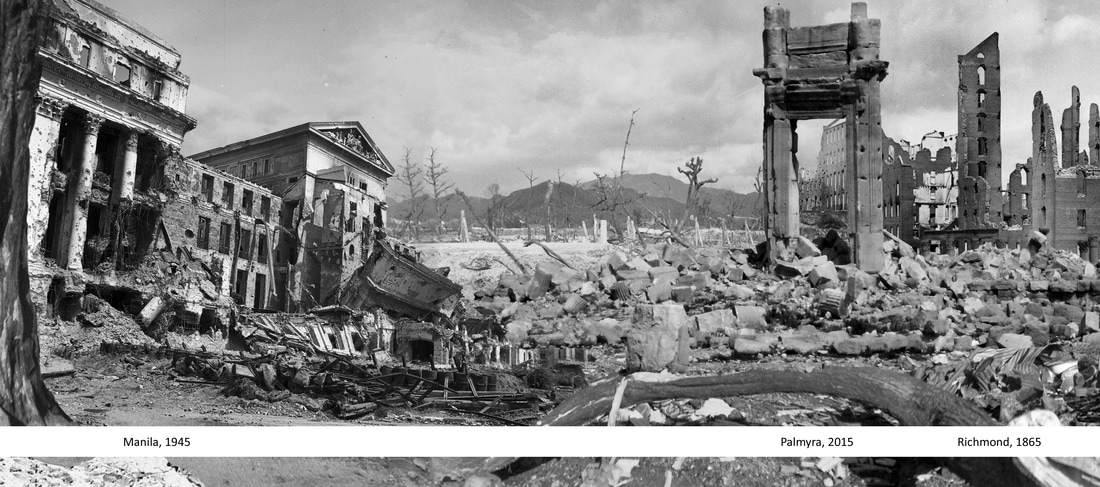The City in Her Desolation
Pennsylvania Academy of the Fine Arts, June 8 - August 23, 2017
"Monumental destruction, Leah Modigliani’s lament at Pennsylvania Academy of the Fine Arts" by Flora Ward
"Show at PAFA Ponders the Fate of Two Spurned Statues," by Edie Newhall
Pennsylvania Academy of the Fine Arts, June 8 - August 23, 2017
"Monumental destruction, Leah Modigliani’s lament at Pennsylvania Academy of the Fine Arts" by Flora Ward
"Show at PAFA Ponders the Fate of Two Spurned Statues," by Edie Newhall
Above photo courtesy of Pennsylvania Academy of the Fine Arts and the Center for the Study of the American Artist.
From the press release:
What power decides why one city is allowed to stand, but not another; why one body is banned from civic space, but not another?
PHILADELPHIA (May 30, 2017) - The Pennsylvania Academy of the Fine Arts (PAFA) presents Leah Modigliani: The City in Her Desolation, on view June 8 - August 23 in PAFA's Morris Gallery, 118 N. Broad Street in Philadelphia.
In this installation, Modigliani explores the history of two works in PAFA's 19th century sculpture collection by examining the changing role of civic engagement through culture.
PAFA's Curator of Contemporary Art, Jodi Throckmorton, notes, "The fate of all cities, and the fragile promise of the social contract of equality for all, is the subject of Modigliani's work, which tracks the banishment of two important works of art - and the eventual reclamation of one."
Based on research of the archives that Modigliani conducted over the past year in PAFA's Study for the Center of the American Artist, she created six new artworks inspired by the fates of two neoclassical figurative sculptures: William Wetmore Story's Jerusalem in Her Desolation (1873) and Giovanni Battista Lombardi's Deborah (1873). Both unveiled to great fanfare at the opening celebration of PAFA's Historic Landmark Building in 1876, these female personifications of the classical world were symbolic of the imagined destiny of the United States as an ascending power rising from the rubble of history.
By 1949, however, aesthetic tastes had changed and the works were marked for de-accessioning. Jerusalem was relocated to a park in Frazer, Pennsylvania, while Deborah was destroyed in 1950 after a new owner could not be found. Although too late to save Deborah, in 1972 PAFA embarked upon a years-long process of reacquiring Jerusalem. Story's sculpture finally returned in 1986, underwent restoration to repair decades of damage from being outdoors, and in 1992 was placed back on display where it remains today.
"I found the narrative of Jerusalem and Deborah so rich in contemporary meanings: female personifications of justice and faith banished or destroyed; ethical questions about the destruction of artworks; the role of visual culture in mediating trauma and politics; the individual's attempt to take responsibility for a collective wrong, and so much more," Modigliani states. "What power decides why one city is allowed to stand, but not another; why one body is banned from civic space, but not another?"
Leah Modigliani, currently Artist-in-Residence at PAFA, is both artist and art historian, studying the history of the avant-garde and its relationship to political critique, the history of conceptual art, social dissent since 1968, and feminist politics of visual representation and discourse. Her creative and scholarly interventions employ the methods and languages of a variety of disciplines including fine arts, art history, critical theory, cultural studies, geography, and anthropology.
What power decides why one city is allowed to stand, but not another; why one body is banned from civic space, but not another?
PHILADELPHIA (May 30, 2017) - The Pennsylvania Academy of the Fine Arts (PAFA) presents Leah Modigliani: The City in Her Desolation, on view June 8 - August 23 in PAFA's Morris Gallery, 118 N. Broad Street in Philadelphia.
In this installation, Modigliani explores the history of two works in PAFA's 19th century sculpture collection by examining the changing role of civic engagement through culture.
PAFA's Curator of Contemporary Art, Jodi Throckmorton, notes, "The fate of all cities, and the fragile promise of the social contract of equality for all, is the subject of Modigliani's work, which tracks the banishment of two important works of art - and the eventual reclamation of one."
Based on research of the archives that Modigliani conducted over the past year in PAFA's Study for the Center of the American Artist, she created six new artworks inspired by the fates of two neoclassical figurative sculptures: William Wetmore Story's Jerusalem in Her Desolation (1873) and Giovanni Battista Lombardi's Deborah (1873). Both unveiled to great fanfare at the opening celebration of PAFA's Historic Landmark Building in 1876, these female personifications of the classical world were symbolic of the imagined destiny of the United States as an ascending power rising from the rubble of history.
By 1949, however, aesthetic tastes had changed and the works were marked for de-accessioning. Jerusalem was relocated to a park in Frazer, Pennsylvania, while Deborah was destroyed in 1950 after a new owner could not be found. Although too late to save Deborah, in 1972 PAFA embarked upon a years-long process of reacquiring Jerusalem. Story's sculpture finally returned in 1986, underwent restoration to repair decades of damage from being outdoors, and in 1992 was placed back on display where it remains today.
"I found the narrative of Jerusalem and Deborah so rich in contemporary meanings: female personifications of justice and faith banished or destroyed; ethical questions about the destruction of artworks; the role of visual culture in mediating trauma and politics; the individual's attempt to take responsibility for a collective wrong, and so much more," Modigliani states. "What power decides why one city is allowed to stand, but not another; why one body is banned from civic space, but not another?"
Leah Modigliani, currently Artist-in-Residence at PAFA, is both artist and art historian, studying the history of the avant-garde and its relationship to political critique, the history of conceptual art, social dissent since 1968, and feminist politics of visual representation and discourse. Her creative and scholarly interventions employ the methods and languages of a variety of disciplines including fine arts, art history, critical theory, cultural studies, geography, and anthropology.
From left to right:
The City in Her Desolation, 2017, archival pigment print on rice paper, bookbinding; Jerusalem, 2017, archival pigment print on rag paper; Deborah, 2017, archival pigment print on rag paper, wood.
The City in Her Desolation, 2017, archival pigment print on rice paper, bookbinding; Jerusalem, 2017, archival pigment print on rag paper; Deborah, 2017, archival pigment print on rag paper, wood.
Top: Detail of Deborah, 2017, archival pigment print on rag paper, wood.
Bottom left: Deborah, 2017, archival pigment print on rag paper, wood; Bottom right: Detail from relief sculpture on wall behind Deborah, Once Great Among the Nations, 2017, mdf, paint drywall
Bottom left: Deborah, 2017, archival pigment print on rag paper, wood; Bottom right: Detail from relief sculpture on wall behind Deborah, Once Great Among the Nations, 2017, mdf, paint drywall
Once Great Among the Nations, 2017, mdf, paint drywall
The english text on the wall is a translation of the latin text carved into the top right of the marble base that supports William Wetmore Story's sculpture Jerusalem in Her Desolation (1873):
How does the city sit alone, when she was once so full of people?
How like a widow is she, who once was great among the nations and a queen among the provinces, now become a slave?
She weeps alone at night with tears upon her cheeks, all her lovers are gone and none can comfort her.
All her friends have betrayed her and have become her enemies.
Artist’s adaptation of Lamentations, Jeremiah, Chapter 1, Verse 1 & 2
The english text on the wall is a translation of the latin text carved into the top right of the marble base that supports William Wetmore Story's sculpture Jerusalem in Her Desolation (1873):
How does the city sit alone, when she was once so full of people?
How like a widow is she, who once was great among the nations and a queen among the provinces, now become a slave?
She weeps alone at night with tears upon her cheeks, all her lovers are gone and none can comfort her.
All her friends have betrayed her and have become her enemies.
Artist’s adaptation of Lamentations, Jeremiah, Chapter 1, Verse 1 & 2
Details from 15 foot long accordion book: The City in Her Desolation, 2017, archival pigment print on rice paper, bookbinding







